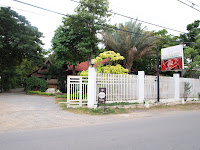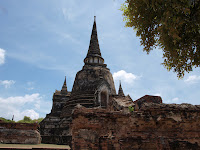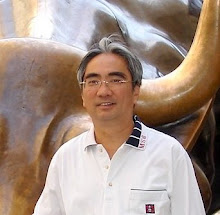



 We turned right to Highway 1 before reaching Tak. The road condition of Highway 1, dual carriage way, is very good. It took us all the way to Ayuthaya about 3 pm. We checked two hotels
We turned right to Highway 1 before reaching Tak. The road condition of Highway 1, dual carriage way, is very good. It took us all the way to Ayuthaya about 3 pm. We checked two hotels within the city but they were fully booked. We moved out of city and found The Old Palace Resort, a small boutique resort with 8 bungalows. We could park our car right in front of our bungalow.
within the city but they were fully booked. We moved out of city and found The Old Palace Resort, a small boutique resort with 8 bungalows. We could park our car right in front of our bungalow.Ayuthaya city, Ancient capital of Thailand
 Ayutthaya city is the capital of the Ayuthaya province. The city was founded in 1350 by King U-Thong and became capital of his kingdom, often referred as Ayuthaya kingdom or Siam. In 1767 the city was destroyed by the Burmese army, the ruins of the old city now form the Ayuthaya historical park. The city was surrounded by the Chao Phraya, Lopburi and the Pasak river. The city became Thailand's capitol in the mid-14th century and remained the capitol until the late 18th century.
Ayutthaya city is the capital of the Ayuthaya province. The city was founded in 1350 by King U-Thong and became capital of his kingdom, often referred as Ayuthaya kingdom or Siam. In 1767 the city was destroyed by the Burmese army, the ruins of the old city now form the Ayuthaya historical park. The city was surrounded by the Chao Phraya, Lopburi and the Pasak river. The city became Thailand's capitol in the mid-14th century and remained the capitol until the late 18th century. The unique round headed Tuk Tuk of Ayuthaya. We had seen enough Wat in this trip. We decided that we should only visit one or two wats and/or museum as Ayuthaya has long history and too many wats.
Wat Na Phra Men
 Wat Na Phra Men is next to The Old Palace Resort. It is one of the very few temples to have escaped destruction by the Burmese. It is not known when the temple was built but restored by King Boromakot and again during the Early Bangkok period. This is a good example of Ayuthaya-style temple.
Wat Na Phra Men is next to The Old Palace Resort. It is one of the very few temples to have escaped destruction by the Burmese. It is not known when the temple was built but restored by King Boromakot and again during the Early Bangkok period. This is a good example of Ayuthaya-style temple. The temple next door houses a stone Buddha seated in European stle, one of the best preserved statues from the Dvaravati era, 6th to 10th century.
Wat Phra Si San Phet
The three bell-shaped chedis of Wat Phra Si Sanphet have practically become a symbol of  Ayutthaya. Wat Phra Si Sanphet was built by King Boromatrailokanat in 1448. It was reportedly one of the grandest temples in the ancient capital, and it is still one of the best preserved on the island. The temple took its name from the large standing Buddha image erected there in 1503. The image stood 16 meters (53 feet) tall and was covered with more than 150 kilograms (330 pounds) of gold. The Buddha was smashed to pieces when the Burmese sacked the city. The gold was gone.
Ayutthaya. Wat Phra Si Sanphet was built by King Boromatrailokanat in 1448. It was reportedly one of the grandest temples in the ancient capital, and it is still one of the best preserved on the island. The temple took its name from the large standing Buddha image erected there in 1503. The image stood 16 meters (53 feet) tall and was covered with more than 150 kilograms (330 pounds) of gold. The Buddha was smashed to pieces when the Burmese sacked the city. The gold was gone.
 Ayutthaya. Wat Phra Si Sanphet was built by King Boromatrailokanat in 1448. It was reportedly one of the grandest temples in the ancient capital, and it is still one of the best preserved on the island. The temple took its name from the large standing Buddha image erected there in 1503. The image stood 16 meters (53 feet) tall and was covered with more than 150 kilograms (330 pounds) of gold. The Buddha was smashed to pieces when the Burmese sacked the city. The gold was gone.
Ayutthaya. Wat Phra Si Sanphet was built by King Boromatrailokanat in 1448. It was reportedly one of the grandest temples in the ancient capital, and it is still one of the best preserved on the island. The temple took its name from the large standing Buddha image erected there in 1503. The image stood 16 meters (53 feet) tall and was covered with more than 150 kilograms (330 pounds) of gold. The Buddha was smashed to pieces when the Burmese sacked the city. The gold was gone. The three large chedis were built to contain the ashes of King Boromatrailokanat and his two sons, King Ramathibodhi and King Boromatrailokanat II. They are considered typical of the Ayutthaya style.


Chantharakasem National Museum
The palace was destroyed by the Burmese army in 1767 A.D. and abandoned until the reign of King Rama IV rebuilt the palace in 1936 and presented it as a national museum. Unfortunately, no camera is allowed inside the buildings.
 The first building, known as the Chaturamuk Pavilion, contains a memorial to King Rama IV and a collection of his personal items such as beds, tables and chairs.
The first building, known as the Chaturamuk Pavilion, contains a memorial to King Rama IV and a collection of his personal items such as beds, tables and chairs. 

In the Phimanrathaya Pavilion you will find a large display of Buddha images and an interesting collection of photographs of the temples.

The Deputy Government Building features period displays ranging from weaponry to costumes.
Japanese Village - Memorial Site of the Old Japanese Settlement Ayutthaya
Ayutthaya was friendly towards foreign traders, including the Chinese, Vietnamese, Indians, Japanese and Persians, and later the Portuguese, Spanish, Dutch and French, permitting them to set up villages outside the city walls. In the sixteenth century, it was described by foreign traders as one of the biggest and wealthiest cities in the East.

Ayutthaya was friendly towards foreign traders, including the Chinese, Vietnamese, Indians, Japanese and Persians, and later the Portuguese, Spanish, Dutch and French, permitting them to set up villages outside the city walls. In the sixteenth century, it was described by foreign traders as one of the biggest and wealthiest cities in the East.

All foreign settlements, except for some Chinese ones, were situated outside the city walls to the south. The Japanese and Dutch communities were located not far from each other. Opposite the Japanese area stood the Portuguese settlement. In the north were the Chinese, Makassarese, French and Vietnamese settlements, while the Laotian community was situated in the northeast and the Muslim settlement near the Takhian canal.
Annex Building of the Ayutthaya Historical Study Center at Japanese Village not only accounted for the Japanese settlement during Ayuthaya Kingdom but also good information of other settlements.
Inside the Annex Building, you would find
Inside the Annex Building, you would find
1. an AV presentation of the history of Japanese migrants to Ayuthaya by Japanese researchers.
2. Products traded during Ayuthaya Kingdom
3. The description of various communities, e.g. Japanese, French etc
4. History time line of Ayuthaya and Japan during the same period
5. Life, culture of the Japanese in their settlement
The museum was informative not only about Japanese in Ayuthaya but also other communities. Unfortunately, we arrived just half hour before closing. We could only glance through the exhibits quickly. To enjoy this museum, one should spend at least an hour ror two.
Ruean Rojjana Thai Restaurant
 Ruean Rojjana Thai Restaurant is on Maharach Road, opposite Ratchaburana Temple. Ratchaburana Temple retains one of the best preserved prang on
Ruean Rojjana Thai Restaurant is on Maharach Road, opposite Ratchaburana Temple. Ratchaburana Temple retains one of the best preserved prang on  the island. The prang was lited at night. We had a good view of the prang from the restaurant. The food was so so but the waitresses were friendly and accommodating. We went to the restaurant around 8.15 pm. By 9 pm, their closing time, we were not done yet. They still maintained their smile and waited patiently for us to complete our meal. They sure knew how to keep customers happy! I wish we could see more of this kind of service level in Singapore.
the island. The prang was lited at night. We had a good view of the prang from the restaurant. The food was so so but the waitresses were friendly and accommodating. We went to the restaurant around 8.15 pm. By 9 pm, their closing time, we were not done yet. They still maintained their smile and waited patiently for us to complete our meal. They sure knew how to keep customers happy! I wish we could see more of this kind of service level in Singapore.
Ruean Rojjana Thai Restaurant
 Ruean Rojjana Thai Restaurant is on Maharach Road, opposite Ratchaburana Temple. Ratchaburana Temple retains one of the best preserved prang on
Ruean Rojjana Thai Restaurant is on Maharach Road, opposite Ratchaburana Temple. Ratchaburana Temple retains one of the best preserved prang on  the island. The prang was lited at night. We had a good view of the prang from the restaurant. The food was so so but the waitresses were friendly and accommodating. We went to the restaurant around 8.15 pm. By 9 pm, their closing time, we were not done yet. They still maintained their smile and waited patiently for us to complete our meal. They sure knew how to keep customers happy! I wish we could see more of this kind of service level in Singapore.
the island. The prang was lited at night. We had a good view of the prang from the restaurant. The food was so so but the waitresses were friendly and accommodating. We went to the restaurant around 8.15 pm. By 9 pm, their closing time, we were not done yet. They still maintained their smile and waited patiently for us to complete our meal. They sure knew how to keep customers happy! I wish we could see more of this kind of service level in Singapore.Hua Hin
From Ayuthaya to Hua Hin, it would be an easy drive of 3 to 4 hours. We planned to have a game of golf at Rose Garden near Bangkok before heading for Hua Hin. We chose Rose Garden because both of us had played there at least 20 years ago. It was Friday and we arrived around lunch time. The 72-hole golf course was closed for private competition. What a shame.



Plan B was shoting for Royal Hua Hin Golf Course. We arrived Hua Hin around 2 pm and went straight to the Royal Hua Hin Golf Course. We teed off at 2.30 pm and finished our round at 6 pm. We managed to complete the round still have some sunlight to spare. This time I won 2 up.
After we freshen up, we drove to Hua Hin town looking for accommodation. The town was extremely quite. Two months ago, when we arrived Hua Hin on our outbound journey, the place was packed. Most of the hotels were full. We had to move on to stay in Cha-An. This time around, we had no problem finding Fresh Inn hotel which was opposite Hilton. The room charge was 7000 vs 900 THB. Fresh Inn Hotel met our needs of Internet, secured car parking and good ambient. Business looked really on a Friday night, no enough Foreign and Local tourists alike.



Ranong is a border town on the eastern side of the Chan River. The opposite side is the southernmost tip of Myanmar, Kawthoung. Many tourists comes to Ranong and take a day trip to Kawthoung for visa renewal. We arrived Ranong in late afternoon and took a break at Ranong port. There was no good reason to stay here for a night. We thought better pressed on to Khao Lak and stayed in one of the resort there.

 Kawthoung/Myanmar
Kawthoung/Myanmar

After we freshen up, we drove to Hua Hin town looking for accommodation. The town was extremely quite. Two months ago, when we arrived Hua Hin on our outbound journey, the place was packed. Most of the hotels were full. We had to move on to stay in Cha-An. This time around, we had no problem finding Fresh Inn hotel which was opposite Hilton. The room charge was 7000 vs 900 THB. Fresh Inn Hotel met our needs of Internet, secured car parking and good ambient. Business looked really on a Friday night, no enough Foreign and Local tourists alike.



Next morning, we took a stroll on the beach. Horseback riding on the beach was a popular  activity. There were many horses on the beach for hire. You can see two ladies was negotiating for horseback riding with the owner. The white sand beach in front of Hiton Hotel is beautiful but rocks are everywhere in the water, not ideal for swiming.
activity. There were many horses on the beach for hire. You can see two ladies was negotiating for horseback riding with the owner. The white sand beach in front of Hiton Hotel is beautiful but rocks are everywhere in the water, not ideal for swiming.
 activity. There were many horses on the beach for hire. You can see two ladies was negotiating for horseback riding with the owner. The white sand beach in front of Hiton Hotel is beautiful but rocks are everywhere in the water, not ideal for swiming.
activity. There were many horses on the beach for hire. You can see two ladies was negotiating for horseback riding with the owner. The white sand beach in front of Hiton Hotel is beautiful but rocks are everywhere in the water, not ideal for swiming. An old lady was digging small oysters on the beach. The size of the oyster was like the kind we used in our fried oyster with egg in Singapore. She has good eye sight and skillful hand coordination. She used a sharp metal object to crack the oyster and digged into the oyster. It would take a good half day to fill up her container.
From Hua Hin to Phuket would need a break in between. We didn’t want to backtrack through Khao Lak National park. We decided to take Highway 4 all the way to Phuket and make a stop somewhere in Ranong or Khao Lak.
Ranong is a border town on the eastern side of the Chan River. The opposite side is the southernmost tip of Myanmar, Kawthoung. Many tourists comes to Ranong and take a day trip to Kawthoung for visa renewal. We arrived Ranong in late afternoon and took a break at Ranong port. There was no good reason to stay here for a night. We thought better pressed on to Khao Lak and stayed in one of the resort there.

 Kawthoung/Myanmar
Kawthoung/Myanmar




















No comments:
Post a Comment